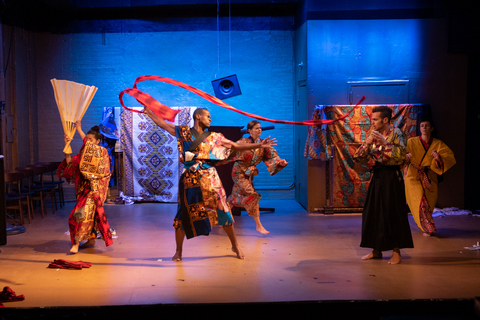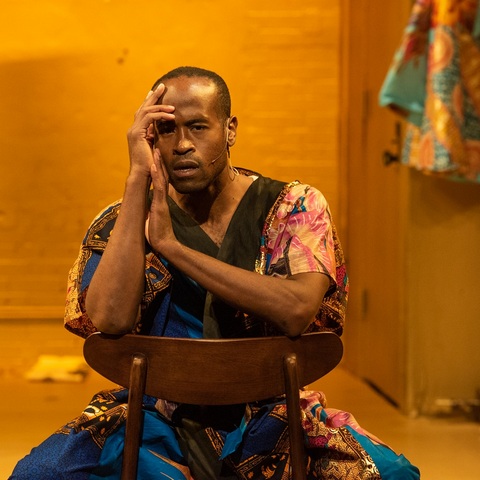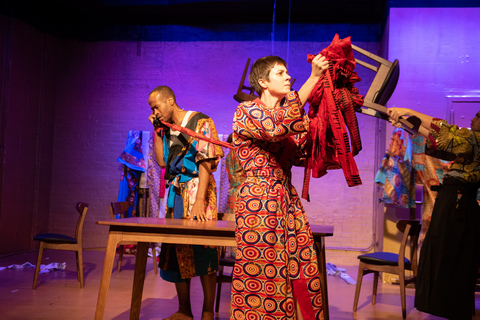BrandoCapote
A fascinating gem that takes a difficult subject and quietly revels in it.

Jennifer McClinton, Rafael Jordan, Lynn R Guerra, Cooper Howell and Laura K Nicoll in a scene from Sara Farrington’s “BrandoCapote” at The Tank (Photo credit: Miguel Aviles)
[avatar user=”Joel Benjamin” size=”96″ align=”left” ] Joel Benjamin, Critic[/avatar]
In 1957 Truman Capote disingenuously misled the legendary actor Marlon Brando into opening up to him under the guise of helping to publicize the soppy melodrama, Sayonara which Brando was then making in Kyoto.
This now infamous interview caused quite a stir for its snarky tone and caustic observations about Asian women. In their BrandoCapote, Sara & Reid Farrington have sliced and diced this article, added music, fanciful Japanese costumes and rather severely stylized choreography and come up with a fascinating theater piece.
The Tank Theater, a small but very busy off-Broadway institution, is hosting BrandoCapote which its creative team—written by Sara Farrington and directed by Reid Farrington—has placed in “Purgatory, which in this case is a hotel room in the Miyako Hotel, Kyoto, Japan in the years between 1957 and 2004.” This evocation is managed quite economically with a nondescript room strewn with plain wooden chairs, a room that also might have been home to Sartre’s No Exit.

Rafael Jordan as Brando in a scene from Sara Farrington’s “BrandoCapote” at The Tank (Photo credit: Miguel Aviles)
Vibrantly colored Japanese style robes and kimonos, designed with a fine eye for detail by Andre Joyner, adorn the six characters: Brando (a robust Rafael Jordan); Capote, or The Devil (a saucy Jennifer McClinton); Dodie, or The Mother (Lynn R. Guerra, brilliantly communicating this woman’s highs and lows); Cheyenne, or The Daughter (Laura K. Nicoll, catching Brando’s daughter’s off-kilter behavior); Christian, or The Son (an aptly ill-tempered Cooper Howell); Voice of Capote, or The Devil (Sara Farrington, not imitating but mocking); and Akiyo Komatsu doing a fine Vocal Impression of Truman Capote on the narrative soundtrack (designed by Marcelo Añez).
The extraordinarily swift changes in Laura Mroczkowski’s lighting help punctuate the action and give it a sense of form, further helped by several ritualistic devices: sudden stops in the choreography indicated by tiny spasmodic movements and the cry, “Let’s get back to the interview”; stage-wide ribbons of cloth, first white, then red, laid out with intense precision in parallel lines by pairs of characters; and the repetition of some movement motifs.
A vertically striped, rainbow curtain, an imitation of a TV test pattern, with the words Please Stand By written across it greets the audience and is suddenly ripped down to begin the 70-minute dance drama. An original coming-attraction of Sayonara wittily sets the mood and the period. Throughout the show videos revealing bits and pieces of Brando’s life and the period are shown on the back wall.

Rafael Jordan, Laura K Nicoll and Cooper Howell in a scene from Sara Farrington’s “BrandoCapote” at The Tank (Photo credit: Miguel Aviles)
Excerpts of the Brando/Capote New Yorker article are bandied about by the cast and on the soundtrack, slowly revealing daunting facts about both their childhoods—how the young Capote was harassed for being effeminate and how Brando’s childhood was haunted by his parents’ totally dysfunctional marriage, then slowly, almost unnoticeably travelling through time to deal with the ordeal of Brando’s son Christian who murdered the boyfriend of Brando’s daughter Cheyenne. Brando rather disingenuously diminishes his acting career rather than revel in his status as the finest actor of his generation. Leonard Bernstein’s Academy Award-winning score from On the Waterfront is constantly quoted, somewhat incongruously considering the Asian ambiance, but it sometimes accompanied videos of Brando in that film.
The tempo of the show reflects that of Noh, the glacially paced—at least to Westerners—classic Japanese theater whose basic tenets were transferred to the performers by Mayo Miwa. Laura Nicoll’s choreography combines the formality of Japanese traditions with modern dance lunges and falls and mime-like gestures.
Slowly, in stops and starts, portraits of the two main characters are revealed. BrandoCapote is more revealing than moving, its extreme stylization and constant repetitions present a façade that is difficult to pierce. But, it is a fascinating gem that takes a difficult subject and quietly revels in it.
BrandoCapote (through November 24, 2019)
The Tank in association with Foxy Films
The Tank, 312 West 36th Street, in Manhattan
For tickets, visit http://www.thetanknyc.org
Running time: 70 minutes without an intermission






Leave a comment